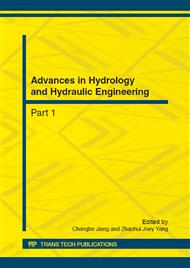p.1103
p.1108
p.1112
p.1119
p.1123
p.1131
p.1136
p.1141
p.1147
Characteristics of Non-Linear Internal Waves in a Three-Dimensional Numerical Wave Tank
Abstract:
Internal waves have a significant impact on the hydrodynamic and stratification characteristics in the density stratified lakes and oceans. In order to reveal the features of internal waves, a three-dimensional numerical wave tank in regular terrain based on the computational fluid dynamics (CFD) model was established to simulate the processes of non-linear internal solitary waves propagation and evolution. The concept of a fraction volume of fluid (VOF) was employed to track the interface of the two-layer fluid. Comparisons were made between CFD model and weakly non-linear KdV theory, it was shown that the wave amplitude predictions by the CFD model agreed well with the KdV equation. On the other hand, the convergence flow and divergence flow at the water surface were captured successfully by the simulated spatial and temporal distributions of velocity. Some peculiar hydrodynamic characteristics, e. g. turbulence kinetic energy and its dissipation rate in the numerical wave tank were also identified and examined. Consequently, this paper provides a reliable method for understanding the phenomenon of internal waves in stratified water bodies.
Info:
Periodical:
Pages:
1123-1130
Citation:
Online since:
October 2012
Authors:
Price:
Сopyright:
© 2012 Trans Tech Publications Ltd. All Rights Reserved
Share:
Citation:


